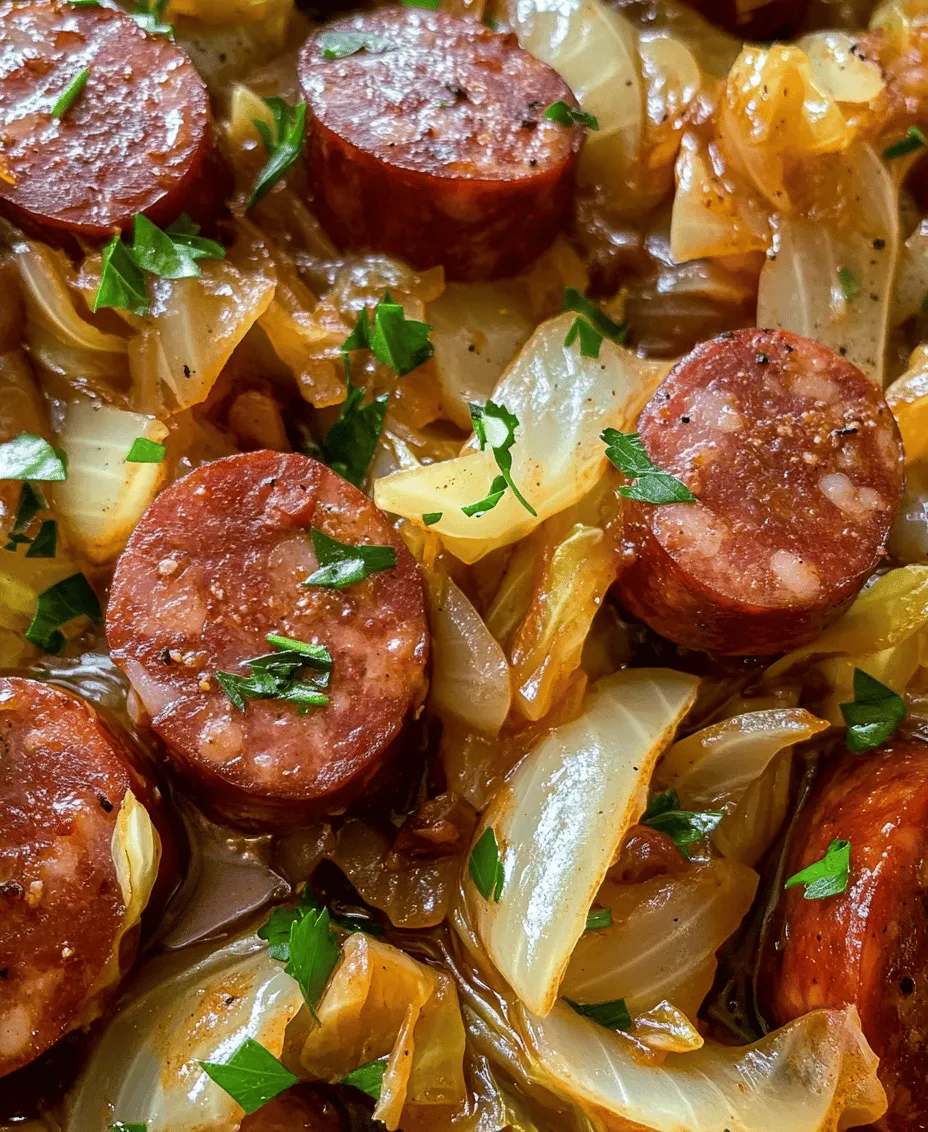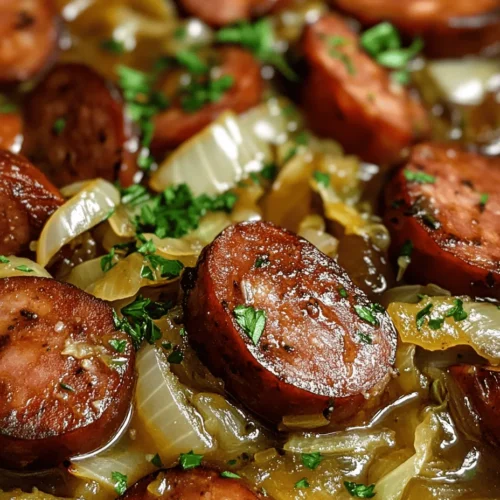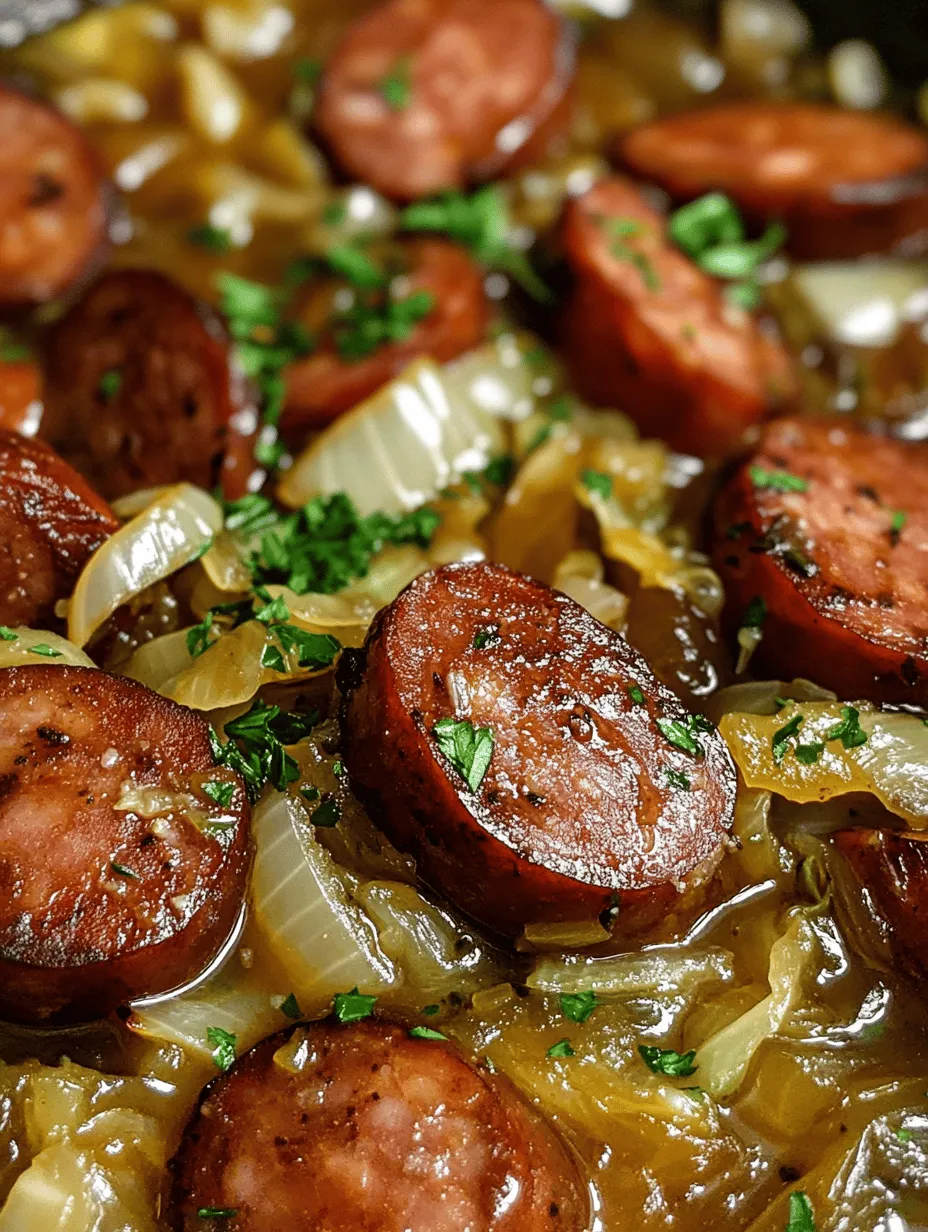Introduction
Kielbasa and cabbage skillet is a hearty, comforting dish that beautifully marries the rich flavors of Polish cuisine with the simplicity of a one-pan meal. Traditionally known as “bigos” or “hunter’s stew,” this dish has roots deeply embedded in Eastern European culinary history. The term “kielbasa” itself translates to “sausage” in Polish and can refer to an array of sausages made from pork, beef, or turkey, often seasoned with garlic and spices. This dish not only showcases the versatility of kielbasa but also highlights the humble cabbage, a staple ingredient in many cultures around the world.
The cultural significance of kielbasa extends beyond just its flavor; it represents family gatherings, festive occasions, and the comforting embrace of home-cooked meals. Across various Eastern European cuisines, kielbasa is celebrated for its robust taste and adaptability. Whether grilled, smoked, or sautéed, it finds its way into stews, soups, and skillet meals, making it a beloved protein choice for many households.
What makes the kielbasa and cabbage skillet particularly appealing is its convenience. In today’s fast-paced world, one-pan meals are a blessing, allowing for easy preparation and minimal cleanup. This dish not only captures the essence of hearty home cooking but also ensures that you can enjoy a flavorful meal without spending hours in the kitchen. The combination of savory kielbasa, tender cabbage, and aromatic spices creates a delicious medley that is both satisfying and nutritious.
Understanding the Ingredients
Overview of Kielbasa
Kielbasa is more than just a sausage; it’s a culinary icon in Polish cuisine. Traditionally made from pork, kielbasa can be found in various forms, including fresh, smoked, and dried. Each type has its own unique flavor profile, influenced by the seasoning and preparation methods used.
Types of Kielbasa:
1. Kielbasa Wiejska (Country Sausage): This is a fresh sausage that is often seasoned with garlic, marjoram, and sometimes smoked for added depth of flavor.
2. Kielbasa Zwyczajna: A smoked sausage that is milder in flavor, commonly enjoyed grilled or in soups and stews.
3. Kielbasa Swojska: A rustic variety that often incorporates a mix of meats and spices, providing a robust and hearty taste.
Nutritional Benefits of Kielbasa:
Kielbasa is a good source of protein, which is essential for muscle repair and growth. It also contains B vitamins, particularly B6 and B12, which play a crucial role in energy metabolism and maintaining healthy nerve cells. However, it is important to be mindful of the sodium content, especially in commercially prepared varieties, which can be high in preservatives and salt.
The Role of Cabbage
Cabbage is the unsung hero of many dishes, particularly in Eastern European cooking, where it has been a dietary staple for centuries. Not only is it versatile and affordable, but it is also packed with nutrients that contribute to a healthy diet.
Health Benefits of Cabbage:
Cabbage is rich in vitamins C and K, both of which are important for immune health and blood clotting, respectively. It is also high in fiber, promoting healthy digestion and contributing to a feeling of fullness, which can aid in weight management. The presence of antioxidants such as sulforaphane makes cabbage a powerful ally against inflammation and chronic diseases.
Different Types of Cabbage:
1. Green Cabbage: The most common type, it has a crisp texture and a slightly peppery flavor. It is often used in slaws, stir-fries, and, of course, the kielbasa and cabbage skillet.
2. Red Cabbage: Rich in anthocyanins, red cabbage offers a slightly sweeter flavor and vibrant color, which can enhance the visual appeal of dishes.
3. Savoy Cabbage: Known for its crinkled leaves, savoy cabbage is tender and has a milder taste, making it great for salads or quick-cooking recipes.
Aromatics and Seasonings
The flavor development in the kielbasa and cabbage skillet is greatly enhanced by the use of aromatics, particularly onions and garlic. These ingredients not only add depth but also provide a fragrant base that elevates the entire dish.
Importance of Onions and Garlic:
Onions contribute natural sweetness and a savory undertone to the dish, while garlic imparts a robust and aromatic flavor. Together, they create a harmonious blend that complements the smokiness of kielbasa and the earthiness of cabbage.
Overview of Paprika and Black Pepper:
Paprika, often a staple in Eastern European cooking, adds a rich, smoky flavor and a vibrant red hue to the dish. It can range from sweet to spicy, allowing for customization based on personal preference. Black pepper, on the other hand, brings a touch of heat and complexity, balancing the flavors beautifully. Both spices also offer health benefits; paprika is rich in antioxidants, while black pepper aids digestion and can enhance nutrient absorption.
Preparation and Cooking Process
Creating the kielbasa and cabbage skillet is a straightforward process that involves a few key steps. Here’s a detailed guide to help you master this dish.
Detailed Steps to Create the Dish
1. Gather Your Ingredients: Start by assembling all the necessary ingredients:
– Kielbasa (your preferred variety)
– Cabbage (green, red, or Savoy)
– Onions
– Garlic
– Paprika
– Black pepper
– Olive oil or butter for sautéing
2. Prepare the Kielbasa: Slice the kielbasa into bite-sized pieces. This allows for even cooking and ensures that the flavors meld together beautifully as the dish comes together.
3. Chop the Vegetables:
– Finely chop the onions. This will help them caramelize nicely and infuse the oil with sweetness.
– Mince the garlic to release its essential oils and flavor.
– Shred or chop the cabbage into strips. This will help it cook down quickly and evenly in the skillet.
4. Sauté the Kielbasa: In a large skillet, heat a tablespoon of olive oil or butter over medium-high heat. Once the oil is shimmering, add the sliced kielbasa. Sauté for about 5-7 minutes or until the sausage is browned. This step is crucial as browning the sausage enhances its flavor, providing a rich, caramelized exterior that adds depth to the dish.
5. Add the Aromatics: After the kielbasa is browned, add the chopped onions to the skillet. Sauté for about 3-4 minutes until they become translucent and start to soften. Then, add the minced garlic and cook for an additional minute, stirring frequently. Be careful not to burn the garlic, as it can turn bitter.
6. Incorporate the Cabbage:
– Gradually add the chopped cabbage to the skillet, stirring to combine with the sausage and onions.
– Season with paprika and black pepper, adjusting to your taste preferences. The cabbage will begin to wilt and reduce in volume as it cooks down, so don’t be alarmed if it looks like a lot at first.
7. Simmer and Cook Through: Once the cabbage is added, lower the heat to medium and cover the skillet with a lid. This will trap steam, helping to soften the cabbage. Allow it to cook for about 10-15 minutes, stirring occasionally to ensure it doesn’t stick to the bottom of the pan.
8. Check for Doneness: The dish is ready when the cabbage is tender and the flavors have melded together. Taste and adjust seasoning if necessary, adding salt or more pepper as desired.
9. Serve: Once cooked, remove the skillet from the heat. Serve the kielbasa and cabbage hot, garnished with fresh herbs if desired. This dish pairs beautifully with crusty bread, mashed potatoes, or can be enjoyed on its own for a low-carb option.
Importance of Cooking Techniques
The cooking techniques used in this recipe—sautéing and simmering—are essential for developing the flavors and textures that make this dish so comforting. Sautéing helps to build a flavorful base with the kielbasa, onions, and garlic, while simmering allows the cabbage to soften and absorb the savory juices from the sausage.
Timing and temperature play a crucial role in ensuring that each ingredient reaches its full potential. A medium-high heat for browning the sausage is necessary to achieve that desirable caramelization, while simmering on a lower heat allows the cabbage to cook gently without becoming mushy.
By following these steps and understanding the role of each ingredient, you’ll be well on your way to mastering the kielbasa and cabbage skillet, a dish that not only nourishes the body but also warms the soul.

Kielbasa and Cabbage Skillet is not just a meal; it’s a comforting dish that embodies a rich cultural heritage and provides a hearty, satisfying experience. Understanding the cooking times and how they affect texture and taste is essential to achieving the perfect result. The right cooking time ensures that the cabbage retains a nice crunch while the kielbasa develops a delightful crispness, all while allowing the flavors to meld beautifully.
Flavor Profile of Kielbasa and Cabbage Skillet
The combination of ingredients in Kielbasa and Cabbage Skillet creates a delightful medley of flavors that are both satisfying and nourishing. The star of this dish, kielbasa, is known for its rich, smoky notes. When sautéed, it caramelizes slightly, releasing a savory essence that infuses the entire dish. The cabbage, on the other hand, contributes a subtle sweetness and tenderness that balances the robustness of the sausage.
Adding seasonings such as garlic, onion, and black pepper enhances the overall flavor profile, making each bite an experience of savory, smoky, and slightly sweet notes. The interplay between these ingredients creates a comforting dish that invites you to savor every bite.
Variations in Seasoning
One of the great things about Kielbasa and Cabbage Skillet is its versatility. While the traditional recipe features garlic and black pepper, feel free to personalize it to suit your taste preferences. For those who enjoy a bit of heat, adding red pepper flakes or a dash of hot sauce can elevate the dish. Alternatively, if you prefer a sweeter touch, consider incorporating a splash of apple cider vinegar or a sprinkle of brown sugar to enhance that natural sweetness of the cabbage.
Experimenting with herbs can also yield delicious results. Thyme, dill, or even caraway seeds can enhance the dish’s depth and complexity. Whether you prefer a more classic flavor or a unique twist, adjusting the spices and seasonings allows you to make this dish your own.
Serving Suggestions
To elevate your Kielbasa and Cabbage Skillet experience, consider some ideal pairings that complement the dish beautifully. A slice of crusty bread is perfect for soaking up the flavorful juices, making each bite even more enjoyable. A dollop of tangy mustard can enhance the savory notes of the kielbasa, providing a delightful contrast that many will appreciate.
For beverage pairings, a cold beer is a classic choice that pairs wonderfully with the smoky flavors of the dish. Alternatively, a crisp white wine or a slightly sweet cider can contrast the savory elements and add to the overall dining experience.
Presentation Ideas
When it comes to presentation, a little garnish can go a long way. Finely chopped parsley not only adds a burst of color but also brings a fresh flavor that brightens the dish. Serve the skillet directly from the stovetop for a rustic feel, or transfer it to a large serving dish to make it more formal. Arranging the cabbage and kielbasa in a visually appealing manner can make the meal feel even more inviting, ensuring your guests are enticed before they even take a bite.
Nutritional Information
Understanding the nutritional value of Kielbasa and Cabbage Skillet is crucial for those mindful of their dietary choices. On average, one serving of this dish contains approximately 350 calories, with a balanced mix of protein, carbohydrates, and fats. The kielbasa provides a hearty source of protein, while cabbage adds fiber and essential vitamins, making this dish a well-rounded meal option.
For those following specific dietary plans, Kielbasa and Cabbage Skillet can fit into various lifestyle choices. It’s low in carbohydrates, making it suitable for low-carb diets, and the protein content satisfies hunger, making it a great option for those seeking to maintain energy levels throughout the day. Adjusting the portion sizes or incorporating more vegetables can enhance the dish’s nutritional profile further while keeping it delicious.
Cultural Context and History
The historical significance of kielbasa in Eastern European cuisine cannot be overstated. Originating from Poland, kielbasa has been a staple in many households for generations. Traditionally made from pork, beef, or a combination of meats, the sausage has deep roots in family gatherings and celebrations. Kielbasa is often associated with comfort food, providing warmth and satisfaction during colder months.
This dish reflects traditional cooking practices, emphasizing the use of simple, hearty ingredients to create a filling meal. In many Eastern European homes, meals like Kielbasa and Cabbage Skillet are not just about nourishment but also about bringing families together around the table. The dish symbolizes a time-honored approach to cooking that values flavor, tradition, and the comfort of home-cooked meals.
Conclusion
In summary, Kielbasa and Cabbage Skillet is a simple yet delicious dish that embodies the essence of comfort food. With its rich flavor profile, easy preparation, and cultural significance, this meal is perfect for any occasion, whether it’s a family dinner or a cozy evening with friends. The adaptability of the recipe allows for personal touches that can cater to individual tastes, making it a versatile addition to your culinary repertoire.
Encourage readers to explore this comforting dish in their kitchens. The ease of preparation, combined with the satisfaction of a hearty meal, makes Kielbasa and Cabbage Skillet a delightful choice for anyone seeking comfort and flavor in their cooking. Embrace the traditions and flavors of this dish, and enjoy the warmth it brings to your dining table.


